This article has been
cited by other articles in ScienceCentral.
Abstract
Purpose
Finger stiffness is a common complication following hand trauma or surgery. Early finger range-of-motion (ROM) exercises have proven to be the most effective method for preventing finger stiffness. In this paper, we introduce a novel finger brace designed for safe and early active exercises and present preliminary results from a small case series.
Methods
Our innovative brace is designed for direct insertion into the finger, ensuring enhanced comfort during use. This brace features hinges that facilitate unrestricted movement in the proximal and distal interphalangeal joints, with each phalangeal component having a rounded shape to prevent rotation. Furthermore, grooves are integrated at the top of the phalangeal components for inserting bars; a straight bar to immobilize and a silicone band to provide elastic resistance exercises within a limited range.
Results
Among 26 patients, 17 presented with fractures, five had extensor tendon injuries, and three had dislocations. For patients not requiring surgery, we applied the brace as early as possible. In cases involving surgery, the brace was applied step by step. When fixation was necessary for the first time, a straight bar was applied, and when starting finger movement, a silicone band was applied. The silicone band was then released to allow free finger movement. Except for one patient necessitating extensor tendon reconstruction due to a neglected rupture, all patients achieved full ROM without any complications.
Conclusion
Our novel ROM finger brace represents a safe and user-friendly option for effectively initiating finger ROM exercises.
Go to :

Keywords: Fingers, Injuries, Contracture, Braces, Articular range of motion
Introduction
Finger stiffness is a prevalent complication following hand trauma or surgery involving tendons, bones, or soft tissue [
1-
3]. This stiffness can result in significant functional impairment, pain, and a decreased quality of life for patients [
4]. Contributing factors to posttrauma or postoperative stiffness include surgical technique, the duration of immobilization, scar tissue formation, and patient-related factors such as age, medical history, and compliance with rehabilitation protocols [
5-
7]. Early recognition and intervention are crucial for preventing or minimizing stiffness, and a multimodal approach to treatment may involve hand therapy, mobilization exercises with appropriate splinting, and medication [
8,
9]. One potential preventative measure is the utilization of a finger brace, which can help maintain range of motion (ROM) and prevent stiffness [
10].
Several shortcomings are associated with currently available dynamic finger splints, including discomfort, skin irritation, limited ROM, cost, and issues with patient compliance [
11]. Depending on the type of dynamic splints used, some patients may experience discomfort or skin irritation from prolonged wear [
12]. While dynamic splint can help maintain some ROM, they can also restrict finger movement and dexterity, making it challenging to perform certain tasks. Furthermore, they can be costly and may not be covered by insurance. Patient compliance with dynamic splint usage recommendations can also be problematic, potentially reducing the treatment’s effectiveness [
13].
In response to these challenges, we have designed and developed small, lightweight, and user-friendly braces as alternatives to the traditional heavy and bulky dynamic splints. These braces are suitable for various finger traumas, allowing immobilization at the onset, elastic resistive ROM exercises in the later stages, and free ROM exercises once sufficient finger strength is regained. Therefore, the aim of this study is to evaluate the effectiveness of our novel ROM finger brace in preventing finger stiffness after hand trauma and surgery.
Go to :

Methods
Ethics statement: This study was conducted after obtaining approval from the Institutional Review Board of Soonchunhyang University Gumi Hospital (No. 2023-08-02). Written informed consent was obtained from the patient for the publication of this study including all clinical images.
1. Description of the brace
Our innovative finger brace stands apart from conventional dynamic splints in its design and function. It’s intended for direct insertion into the finger, enhancing comfort during use. The brace incorporates hinges that facilitate unrestricted movement in the proximal and distal interphalangeal joints, while each phalangeal component is shaped like a rounded wrap to prevent rotation during exercises (
Fig. 1). In this brace, the ROM in the proximal and distal interphalangeal joint is 0° to 90° (
Fig. 2). Unlike other fingers, the thumb has only two phalanges and is thicker, so the brace for the thumb is made separately from other fingers (
Fig. 3).
 | Fig. 1.The appearance of the finger brace. (A) Extension state. (B) Flexion state. 
|
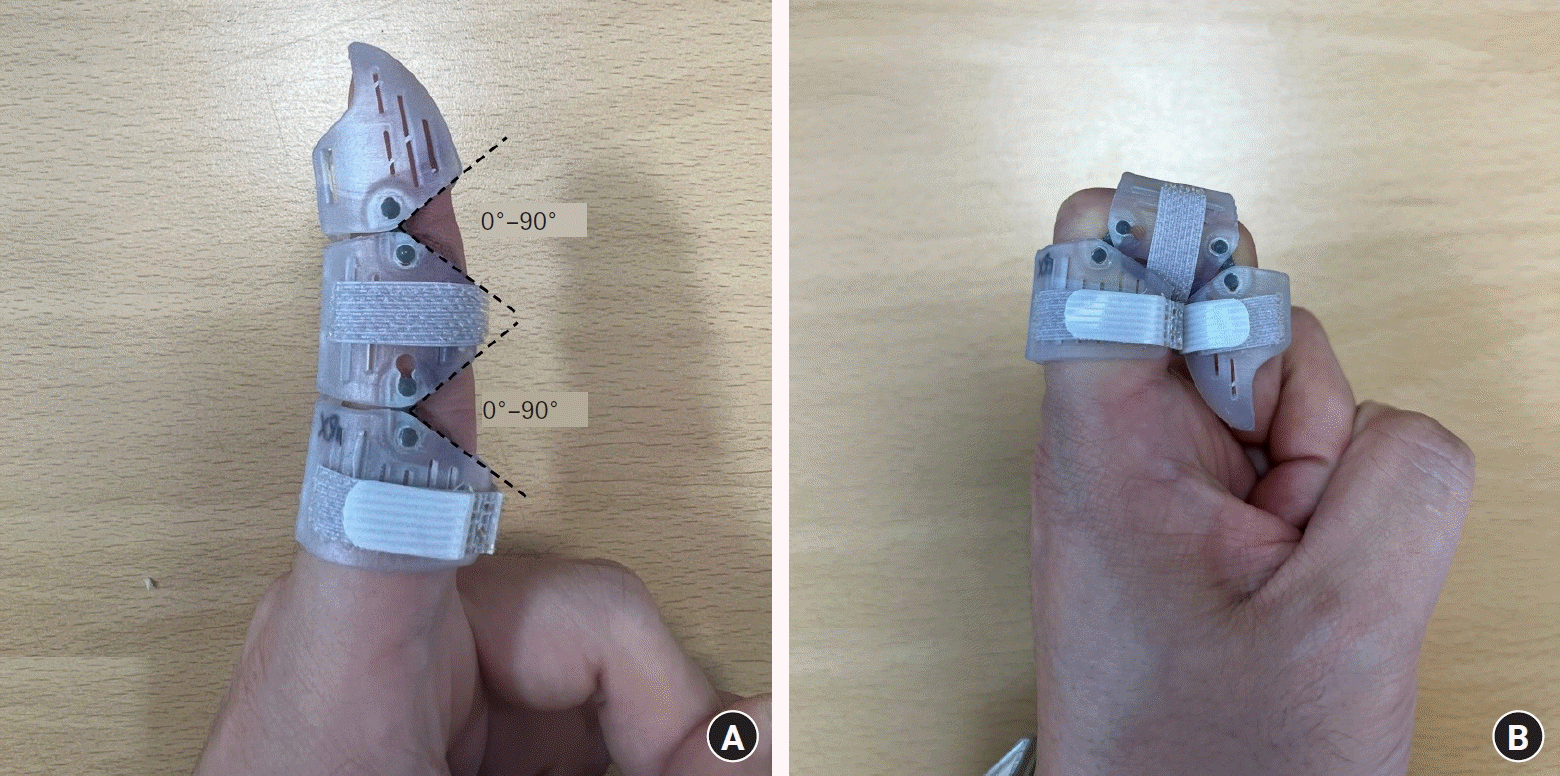 | Fig. 2.The range of motion of the brace is 0° to 90° for both the proximal and distal interphalangeal joints. (A) Extension state. (B) Flexion state. 
|
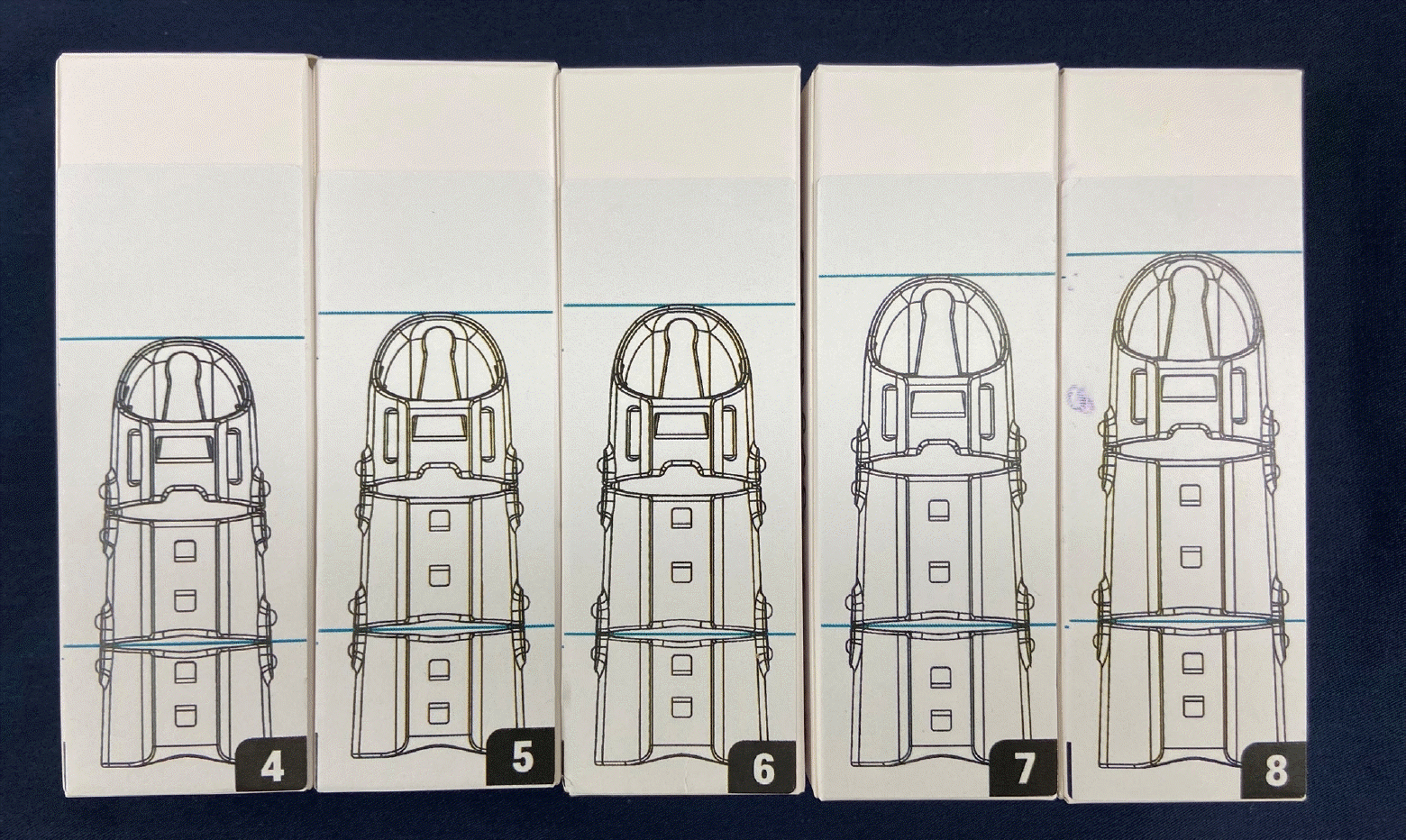 | Fig. 3.Because the thumb has different anatomical features from other fingers, we made a separate brace just for the thumb. One hinge is used for the thumb, and two hinges are used for the other finger. (A) Comparison from above. (B) Comparison from the side. 
|
Since the size of each component should also vary depending on the length of the finger segment, a total of eight sizes were made at 5-mm intervals from the smallest length (
Fig. 4) by referring to the average Korean finger lengths [
14]. The picture printed on the product box has the same size as the actual product shape, so it is designed to be worn after confirming that the length is correct through the picture on the box before actually wearing it (
Fig. 5). Circumference varies depending on the condition of the wound and the period from the date of trauma, so it was made possible to match the strap by adjusting it.
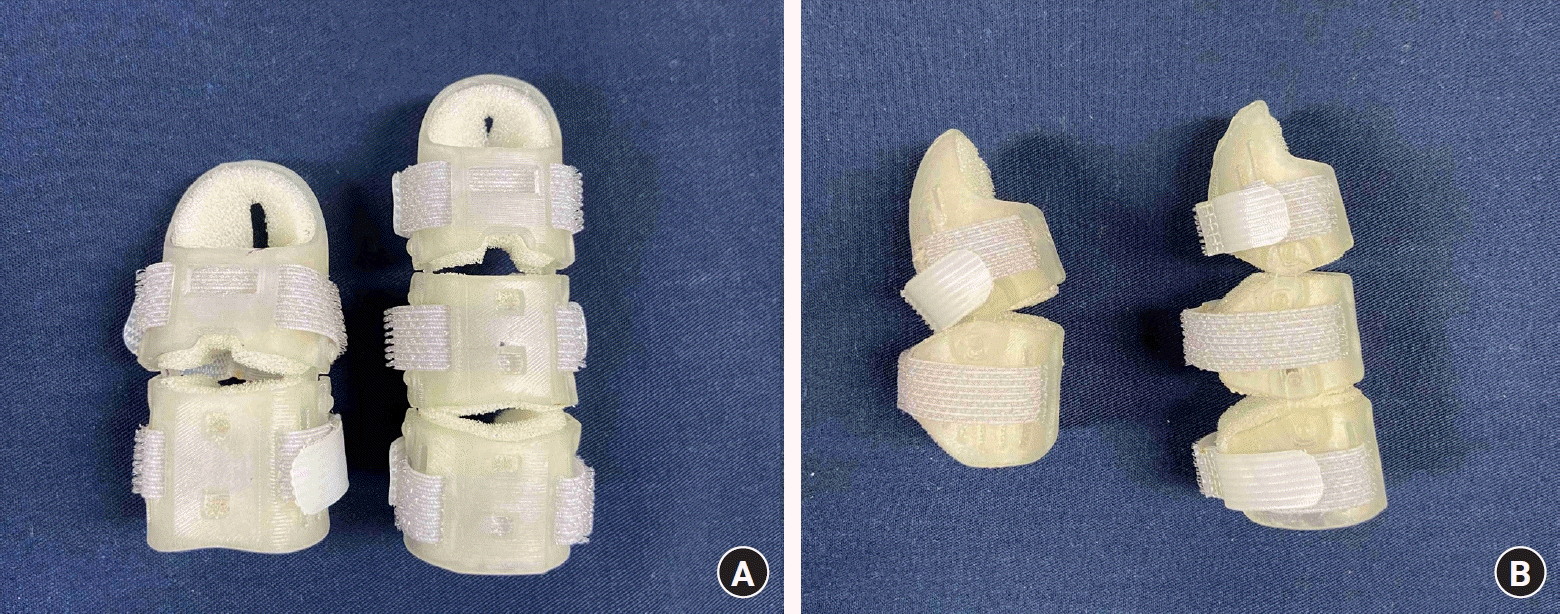 | Fig. 4.Eight sizes were prepared for each 5-mm length so that an appropriate option could be chosen according to the finger size. 
|
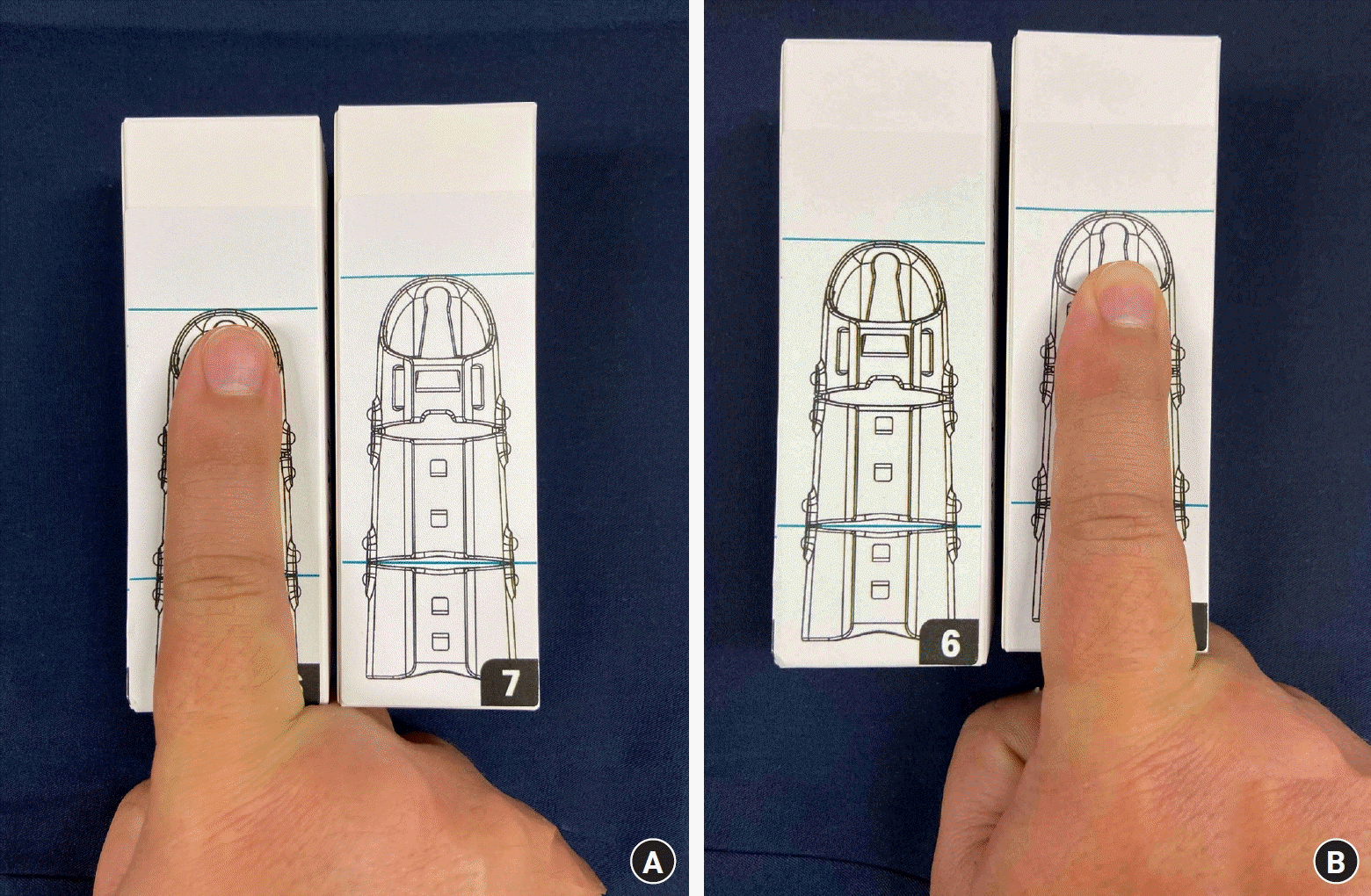 | Fig. 5.The brace box is printed with a picture of the actual size of the brace, so it is possible to check for a proper brace size that fits the length of one’s finger without wearing it. (A) Appropriate brace size for finger length. (B) Longer brace size than finger length. 
|
Furthermore, grooves are strategically positioned at the top of the phalangeal components to accommodate bars, allowing controlled limitation of finger movement. These bars come in two types: a straight bar that prevents flexion and a silicone band that permits resistant active exercises within a specified range (
Fig. 6). As soon as it’s determined that the wound can tolerate the brace, patients are encouraged to begin wearing it promptly, and active exercises are initiated accordingly.
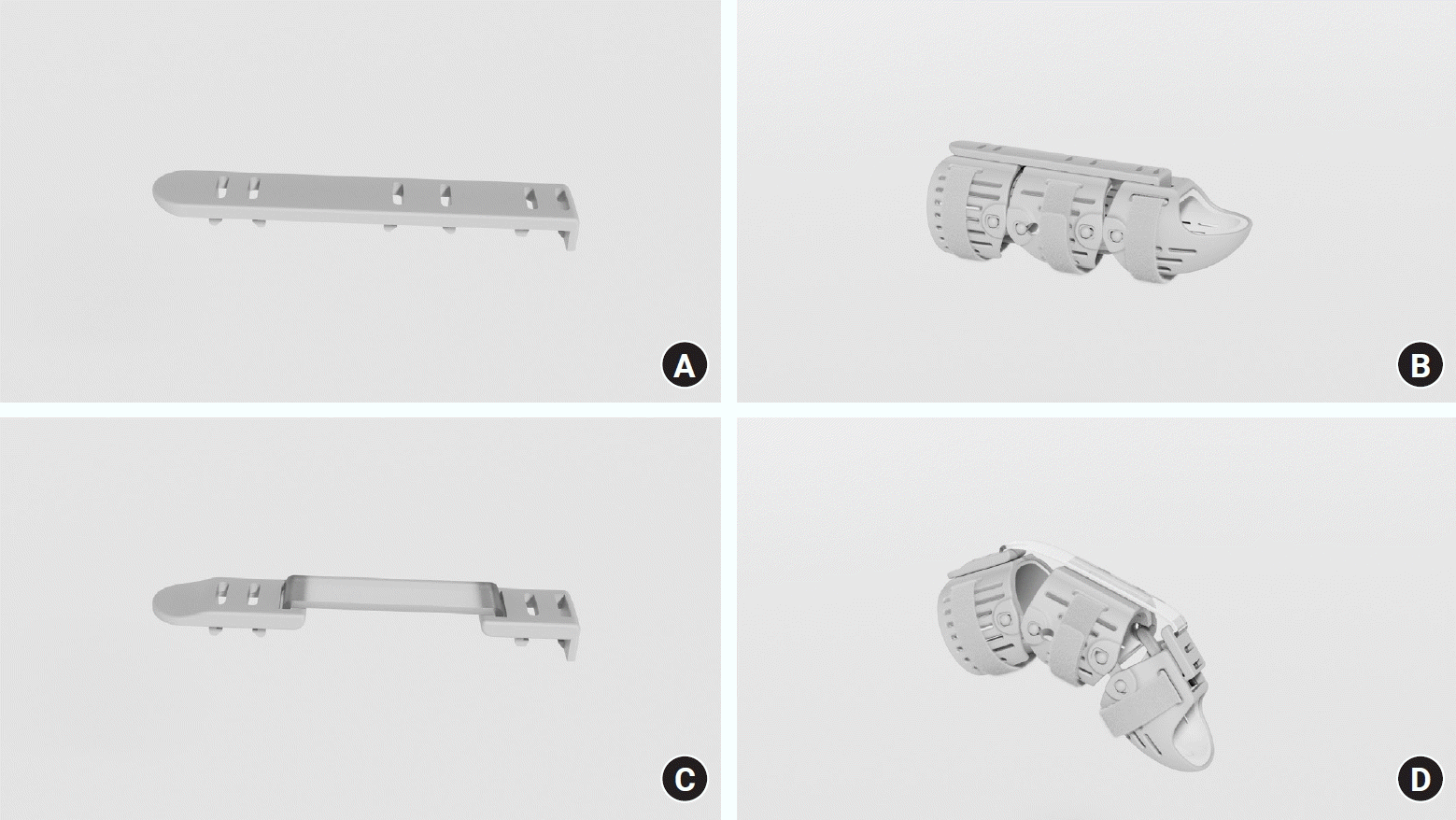 | Fig. 6.Two kinds of bars. (A) Straight bar: blocking the movement. (B) Wearing a straight bar on the finger brace body. (C) Silicone band allowing elastic resistance-based range-of-motion exercises. (D) Wearing a silicone band on the finger brace body. 
|
2. When and how to apply the brace
In the case of phalanx fractures that do not necessitate surgery, our protocol involves initial immobilization using the finger brace with the straight bar. Following 2 weeks of brace wear, we introduce limited, resistant active ROM exercises employing the silicone band, contingent upon a reduction in finger swelling. After an additional week of silicone band use, we conduct an X-ray assessment. If no fracture displacement or angulation is detected, we remove the silicone band, enabling unrestricted ROM exercises while patients continue wearing the brace.
In situations requiring surgery for phalanx fractures, we apply a finger brace equipped with a straight bar after removing the suture at 2 weeks after surgery. After 1 to 2 weeks, provided there are no anomalies evident in the X-ray images or finger mobility, we remove the straight bar and applied a silicone band. It is recommended to perform appropriate active exercise that does not cause fracture site dislocation during the 3 to 4 weeks of surgery with limited stability after surgery [
4,
15]. After an additional 1 to 2 weeks, we remove the silicone band, permitting free active ROM exercises.
In cases involving surgery due to extensor tendon injury, the treatment course begins with the application of a general finger splint, which remains in place until suture removal during the second week after surgery. Following suture removal, we introduce a finger brace with a straight bar. At 3 to 4 weeks after surgery, an ultrasound examination is performed to confirm the proper healing of the sutured extensor muscle. In the absence of complications, the straight bar is replaced with a silicone band to initiate resistant active ROM exercises. After 1 additional week, we remove the silicone band, permitting free active ROM exercises.
In instances of dislocation, if the instability is not severe, finger free ROM exercises are started as soon as possible by wearing the finger brace without the straight bar or silicone band within 1 week of the trauma.
3. Clinical measurement of range of motion
Since patients can perform ROM exercises without angle limitations once the silicone band is removed, finger ROM measurements were taken 1 to 2 weeks later. Additionally, X-rays were examined to confirm the absence of abnormalities in the surgical or trauma area.
Go to :

Results
In this study, we enrolled 26 patients who experienced finger trauma, including fractures, extensor tendon injuries, and dislocations, between December 2022 and July 2023. Among them, 18 had fractures, five had extensor tendon injuries, and three had dislocations (
Table 1). The average age of the patients was 47.3 ± 13.8 years, with females comprising 19.2% of the patients. Fracture distribution included nine distal phalanx fractures, six proximal phalanx fractures, and three middle phalanx fractures, totaling 18 fracture cases.
Table 1.
|
Patient No. |
Age (yr) |
Sex |
Diagnosis |
Site |
Surgery |
|
1 |
67 |
Female |
Proximal phalanx fracture |
Right second finger |
O |
|
2 |
15 |
Male |
Middle phalanx fracture |
Left second finger |
X |
|
3 |
57 |
Female |
Extensor tendon partial rupture |
Left fifth finger |
O |
|
4 |
45 |
Male |
Distal phalanx fracture |
Left fourth finger |
O |
|
5 |
43 |
Male |
Ignored extensor tendon rupture |
Left fifth finger |
O |
|
6 |
54 |
Male |
Middle phalanx fracture |
Left fourth finger |
O |
|
7 |
66 |
Male |
Middle phalanx fracture |
Right second and third fingers |
X |
|
8 |
56 |
Male |
Distal phalanx fracture |
Left fourth finger |
O |
|
9 |
38 |
Male |
Distal phalanx fracture |
Left third finger |
X |
|
10 |
38 |
Male |
Distal phalanx fracture |
Left fourth finger |
X |
|
11 |
43 |
Male |
Proximal interphalangeal dislocation |
Left fifth finger |
X |
|
12 |
39 |
Male |
Distal phalanx fracture |
Right first finger |
X |
|
13 |
64 |
Male |
Extensor tendon partial rupture |
Right second finger |
O |
|
14 |
49 |
Female |
Proximal phalanx fracture |
Right fourth finger |
O |
|
15 |
68 |
Male |
Distal interphalangeal dislocation |
Right fifth finger |
X |
|
16 |
58 |
Female |
Proximal phalanx fracture |
Left fourth finger |
O |
|
17 |
47 |
Male |
Extensor tendon partial rupture |
Left second finger |
O |
|
18 |
21 |
Male |
Proximal phalanx fracture |
Right second finger |
X |
|
19 |
47 |
Female |
Distal phalanx fracture |
Right second finger |
O |
|
20 |
56 |
Male |
Extensor tendon complete rupture |
Left second finger |
O |
|
21 |
39 |
Male |
Distal phalanx fracture |
Left fifth finger |
X |
|
22 |
23 |
Male |
Proximal phalanx fracture |
Left fifth finger |
O |
|
23 |
65 |
Male |
Proximal phalanx fracture |
Right second finger |
X |
|
24 |
46 |
Male |
Distal phalanx fracture |
Right third finger |
X |
|
25 |
40 |
Male |
Distal phalanx fracture |
Left fifth finger |
O |
|
26 |
44 |
Male |
Proximal interphalangeal dislocation |
Right fifth finger |
X |

Out of the 18 fracture patients, nine patients required surgery. Among these, four patients conducted closed reduction and percutaneous pinning, while the remaining five patients performed open screw or plate fixation. Extensor muscle injuries in all patients underwent tenorrhaphy. In cases of joint dislocation, immediate manual reduction sufficed, and surgical interventions were unnecessary.
With the exception of one patient who underwent extensor tendon reconstruction due to a neglected extensor tendon rupture, all patients achieved full ROM after applying the finger brace without using the silicone band. Unfortunately, the patient who underwent extensor tendon reconstruction experienced an unsuccessful outcome and subsequently required fusion of the distal interphalangeal joint. It’s important to note that the failure of the tendon reconstruction is not attributed to issues with the brace.
1. Case 1
A 47-year-old female patient sustained an injury to her right second finger when her hand was caught in a door. She was diagnosed with a distal phalanx open fracture. The fracture fragment was severely displaced, necessitating suturing of the open wound with Kirschner wire (K-wire) fixation. Sutures were removed in the second week after surgery, followed by the removal of the K-wire in the 3rd week. Subsequently, elastic resistive active ROM exercises, using a silicone band, were initiated. Four weeks after surgery, free ROM exercises were permitted without the use of a bar (
Fig. 7). The patient progressively increased finger ROM without encountering any difficulties, and by the 4th week after surgery, there were no restrictions on ROM.
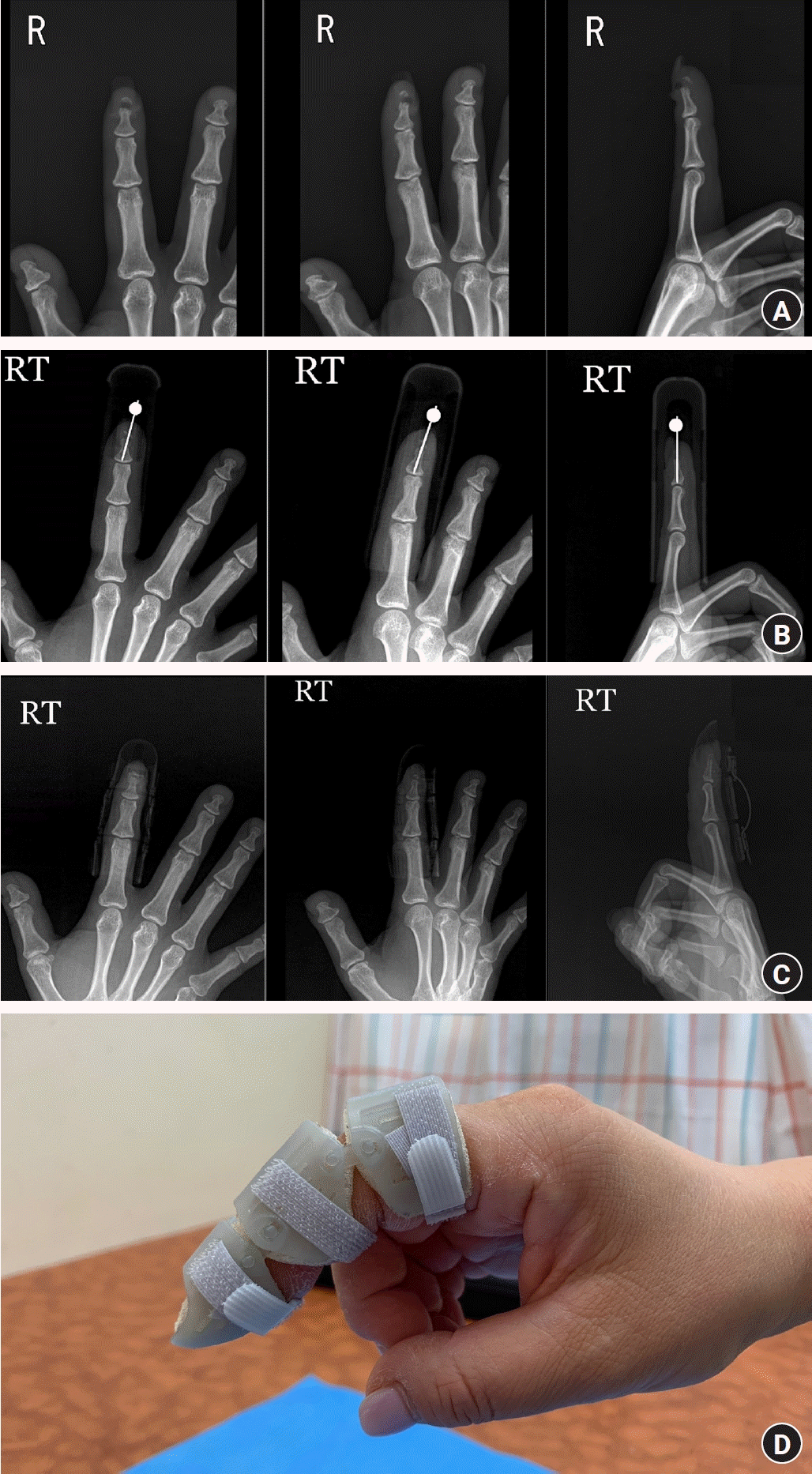 | Fig. 7.(A) Immediate radiograph showing a right second distal phalanx open fracture with displacement. (B) Plain X-ray after Kirschner wire (K-wire) fixation. (C) The K-wire was removed at 3 weeks after surgery, and the fracture fragment was well reduced. (D) Photo of the patient wearing the finger brace without a silicone band: Working out for full flexion. 
|
2. Case 2
A 57-year-old female patient sustained a cut to her fifth finger while cooking with a kitchen knife. She sought care at our outpatient clinic, where she was diagnosed with a partial rupture affecting approximately 70% of the extensor tendon around the proximal interphalangeal joint area in her left fifth finger. This condition necessitated tenorrhaphy, which was performed and subsequently removed in the second week after surgery. For approximately 1 week, the patient wore a finger brace with a straight bar. After confirming the absence of abnormalities in the sutured extensor tendon through ultrasound examination, a silicone band was applied instead of the straight bar to commence active finger ROM exercises (
Fig. 8). One week later, the patient regained full freedom of finger movement.
 | Fig. 8.(A) Clinical photo of a 57-year-old female patient wearing the finger brace with a silicone band applied. (B) Clinical photo of the patient wearing the finger brace without a silicone band. (C) Clinical photo of a 65-year-old male patient wearing the finger brace with a silicone band applied. 
|
3. Case 3
A 65-year-old male patient injured his right hand when he fell from a 2-m-high ladder and sought immediate medical attention at the emergency room. In the emergency room, he was diagnosed with a proximal bone fracture of his right second finger and was subsequently transferred to the orthopedics department for treatment. Imaging tests revealed no displacement between the fracture fragments, but there was severe swelling. As an initial measure, immobilization was performed using a finger brace with a straight bar. After 2 weeks of immobilization, when the swelling had somewhat subsided, the straight bar was replaced with a silicone bar to initiate elastic-resistant finger ROM exercises. During the second week of using the silicone bar, after confirming the patient’s ability to perform resistance exercises effectively, the silicone bar was removed, allowing for free finger exercises (
Fig. 9). Ultimately, the patient achieved full mobility in his right second finger without the need for surgery.
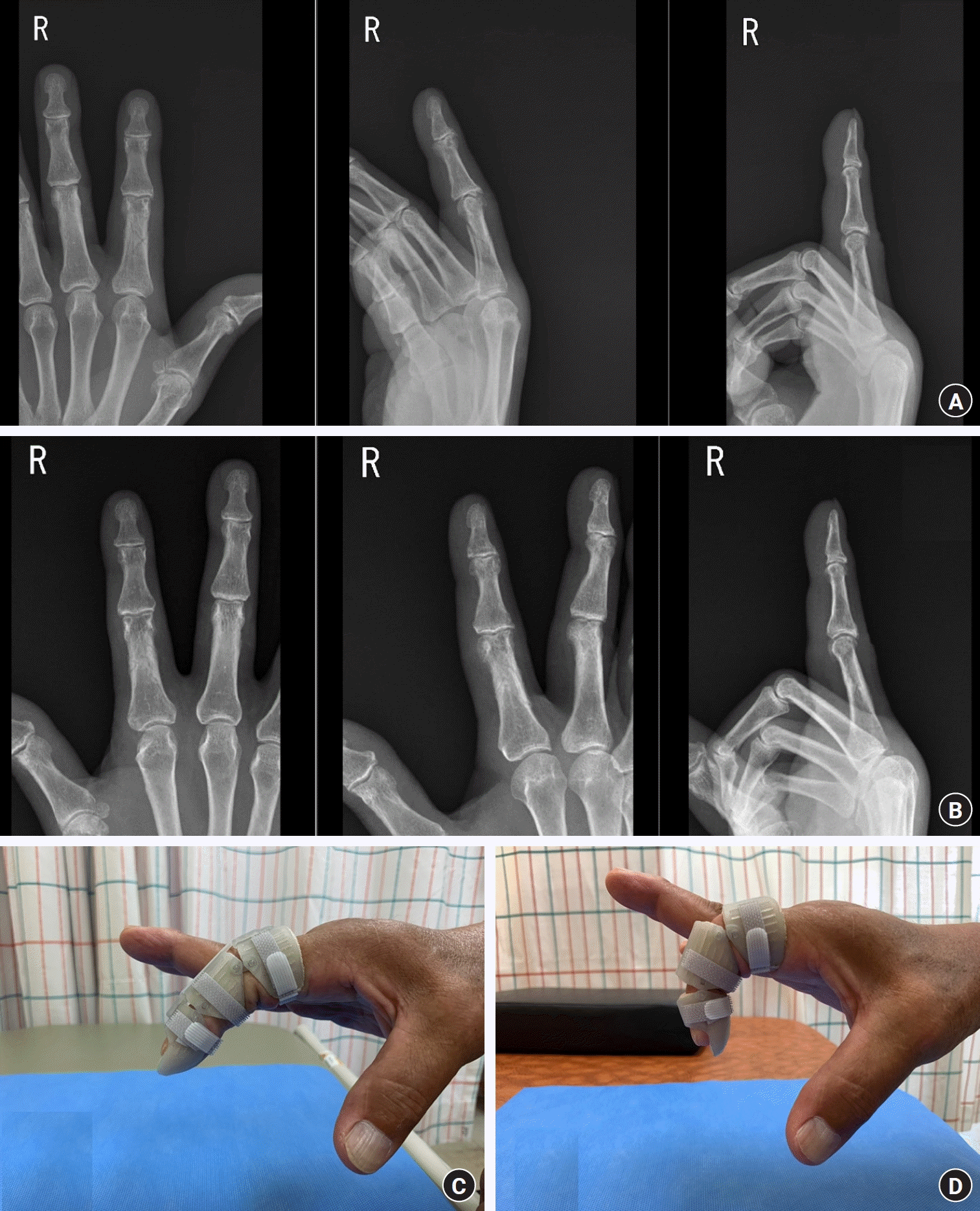 | Fig. 9.(A) Immediate radiograph revealing a right second proximal phalanx fracture with slight displacement. (B) After 3 months of treatment, an X-ray examination confirmed that all fractures were fused. (C) Clinical photo of a 65-year-old male patient wearing the finger brace with a silicone band applied. (D) Clinical photo of the patient wearing the finger brace without a silicone band: full flexion available. 
|
Go to :

Discussion
Finger stiffness frequently occurs as a complication following hand trauma or surgery, potentially hampering a patient’s capacity to carry out everyday tasks [
8,
16]. One viable preventative measure is the utilization of a finger brace, as it may aid in preserving movement and averting stiffness [
10].
The current study introduces an innovative finger brace specially crafted to expedite posttrauma or postoperative rehabilitation. The primary purpose of this aid was to create a device that seamlessly combines user-friendliness with the effect of supporting and accelerating the recovery of finger injuries. We focused on enabling it to be used as a single brace in various conditions, either posttraumatic or postoperative time and encompassing phalangeal fractures, extensor tendon injuries, and dislocations.
Immediately after trauma or surgery, it is better to take stability through immobilization rather than rehabilitation treatment of water parts due to edema and pain [
10]. By inserting a straight bar, we can easily achieve the immobilization of the injured finger. After some immobilized period, early exercise with proper stability is effective in preventing stiffness in the fingers. In this respect, it is well known that dynamic finger splints are effective [
17,
18]. Also, joint stiffness was relieved using an elastic resistance exercise protocol in the early postoperative period [
15]. Unlike conventional dynamic finger splints, our new assistants are designed to allow resistive elastic motion within a set range while wearing simpler and more stable assistants by inserting a silicone band instead of a straight bar. When the patient is good at resistive elastic exercise to some extent, free finger movement is performed by removing the silicone band. This adaptability of the brace to various categories of finger injuries and periods renders it an invaluable instrument for hand surgeons and physicians striving to enhance posttrauma and postoperative care.
The key finding of this study is the natural recovery of finger ROM when using our novel finger brace. Our results indicate that the brace significantly reduces discomfort and limited ROM, providing stable and targeted support to the injured finger. The unique design of the brace allows for easy adjustment and personalized fitting, ensuring optimal positioning and alignment of the finger during the healing process. The intuitive application of the brace empowers patients to actively participate in their rehabilitation journey, potentially accelerating recovery time and overall functional outcomes.
Although the results of this study are encouraging, we acknowledge certain limitations, such as the relatively small sample size and the absence of long-term follow-up data. Future research endeavors should aim to conduct larger clinical trials with extended monitoring periods to further validate the efficacy and durability of the finger brace. While there is some evidence to suggest that finger bracing may be effective in preventing posttrauma and postoperative finger stiffness, more research is needed to determine the optimal type and duration of bracing for different surgical procedures and patient populations. Furthermore, the grooves that can be inserted are on the dorsal side of the component, making it difficult to use for flexor tendon injury because they cannot remain bent until now. In the future, accessories will be developed for use in damage to the flexor tendons.
Go to :

Conclusion
Early finger ROM exercise after hand trauma is important in preventing finger stiffness. This study presents a groundbreaking advancement in posttrauma finger rehabilitation through the development of a user-friendly and effective finger brace. The significant improvement observed in patient outcomes underscores the potential of this device to revolutionize the field of hand surgery and rehabilitation. As our understanding of its impact continues to grow, the novel finger brace holds promise in transforming the recovery process for countless individuals with finger injuries, ultimately enhancing their quality of life and functional restoration. Novel ROM finger brace can be a good option for safe and easy initial finger ROM exercise.
Go to :

Notes
Go to :

ACKNOWLEDGMENTS
This research was supported by the National Research Foundation of Korea (NRF) grant funded by the Korea government (MIST) (No. RS-2022-00166614).
Go to :

References
1. Chae S, Park IJ. Management of metacarpal and phalangeal fractures. Arch Hand Microsurg. 2023; 28:75–86.

2. Yang S, Kim JP. Hand fractures. J Korean Fract Soc. 2018; 31:61–70.

3. Meals C, Meals R. Hand fractures: a review of current treatment strategies. J Hand Surg Am. 2013; 38:1021–31.

4. Hardy MA. Principles of metacarpal and phalangeal fracture management: a review of rehabilitation concepts. J Orthop Sports Phys Ther. 2004; 34:781–99.

5. Onishi T, Omokawa S, Shimizu T, Fujitani R, Shigematsu K, Tanaka Y. Predictors of postoperative finger stiffness in unstable proximal phalangeal fractures. Plast Reconstr Surg Glob Open. 2015; 3:e431.

6. Pun WK, Chow SP, So YC, et al. A prospective study on 284 digital fractures of the hand. J Hand Surg Am. 1989; 14:474–81.

7. Page SM, Stern PJ. Complications and range of motion following plate fixation of metacarpal and phalangeal fractures. J Hand Surg Am. 1998; 23:827–32.

9. Kaplan FT. The stiff finger. Hand Clin. 2010; 26:191–204.

10. Yang G, McGlinn EP, Chung KC. Management of the stiff finger: evidence and outcomes. Clin Plast Surg. 2014; 41:501–12.
11. Nakayama J, Horiki M, Denno K, Ogawa K, Oka H, Domen K. Pneumatic-type dynamic traction and flexion splint for treating patients with extension contracture of the metacarpophalangeal joint. Prosthet Orthot Int. 2016; 40:142–6.

12. Ueba Y, Kurata H, Ono I. Basic biomechanics for orthotic therapy of the hand. Bull Jpn Soc Prosthet Orthot. 1999; 15:119–24.
13. Nakayama J, Kurokawa K, Konishi A. A trial of a revolving-type dynamic traction splint for extension contracture of the metacarpophalangeal joint. Jpn Occup Ther Res. 2008; 27:168–73.
14. Kee DH. Characteristics of hand dimensions and hand scale for Koreans. J Korean Inst Ind Eng. 2011; 37:55–63.

15. Jun D, Jeong M, Shin D, Choi H, Kim J, Lee M. Treatment of phalangeal joint stiffness related to proximal phalangeal bone fractures: therapeutic effects on the range of motion and finger pain. Arch Hand Microsurg. 2021; 26:254–64.

16. Freeland AE. Closed reduction of hand fractures. Clin Plast Surg. 2005; 32:549–61.

17. Fess EE, Gettle KS, Strickland J, Barber LM. Hand splinting: principles and methods. Plast Reconstr Surg. 1982; 69:373.
18. Weeks PM, Wray RC Jr, Kuxhaus M. The results of non-operative management of stiff joints in the hand. Plast Reconstr Surg. 1978; 61:58–63.

Go to :








 PDF
PDF Citation
Citation Print
Print









 XML Download
XML Download